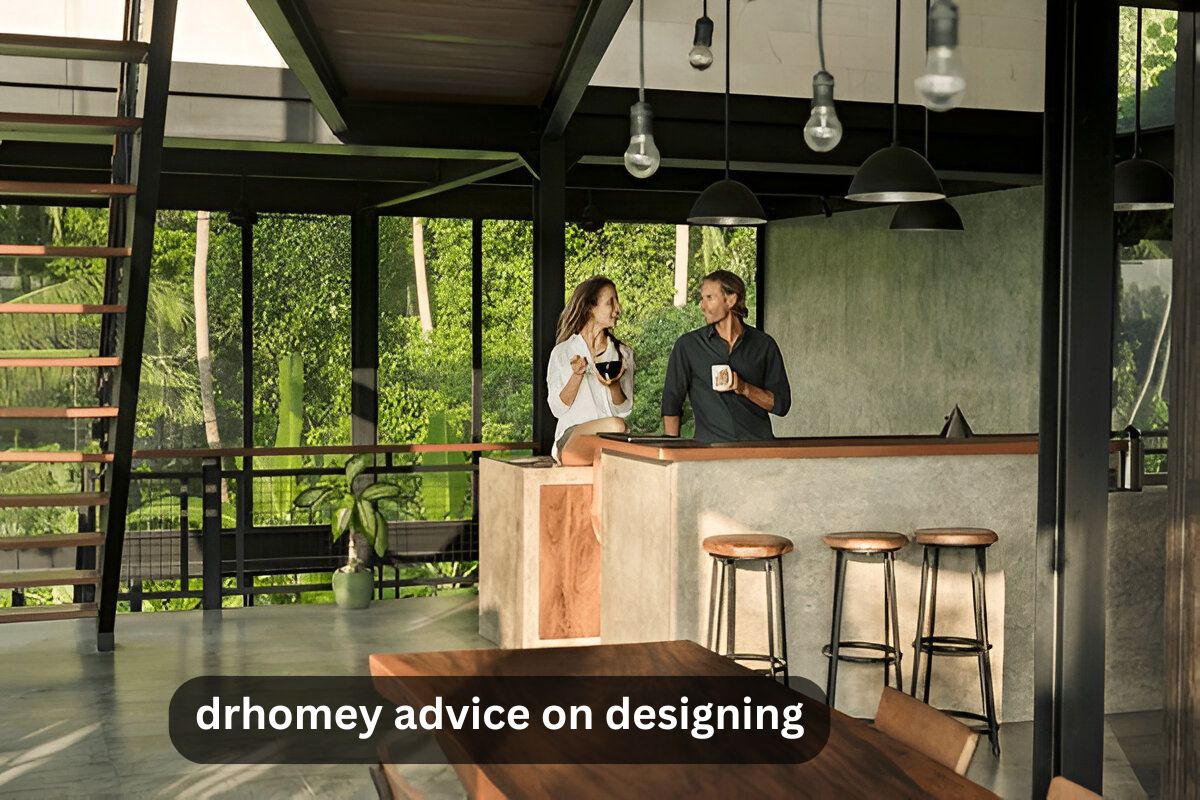Design should make daily life easier. That is the heart of drhomey advice on designing. You want rooms that look good and work well. You care about comfort, safety, and value. This guide keeps it simple. It cuts jargon. It focuses on real choices that help people in the United States. You will see drhomey advice on designing applied to space planning, color, lighting, storage, kid-friendly choices, outdoor areas, and energy comfort. You will also see examples and data where it helps. Each section gives clear steps you can use today. No fluff. No hype. Just useful ideas based on research and practice. By the end, you will know how to make smarter design moves with confidence. You will also see how to measure what works for you. That is drhomey advice on designing that respects your time and budget.
What drhomey advice on designing means today
Drhomey advice on designing starts with people. Your daily needs set the brief. Looks matter, but use follows. Good design lowers stress. It shortens chores. It cuts waste. It lowers cost over time. That is the point. Many guides and tips drhomey share this same balance of function and comfort.
Start with one or two rooms that matter most. Kitchen and living areas touch daily life. You will get the biggest return there. Then move to bedrooms and entries. This staged plan reflects drhomey advice on designing across many posts on dr homey .com, which favors practical moves you can do on weekends.
A balanced home blends function and feeling. Pick one clear goal for each space. A quiet place to read. A sturdy place for family meals. A safe area for a toddler. Keep that aim in mind as you plan. That is drhomey advice on designing in simple form.
Start with space and flow
Room layout shapes every choice. Start with accurate measures. Mark doors, windows, and outlets. Map traffic paths from door to sofa to kitchen. Experts and drhomey handy tips both stress that you place large items first and then work around them. Leave clear paths so people do not bump into corners. Use empty space as a tool. It gives the eye rest and makes a room feel larger.
Pick one focal point. It can be a window view, a fireplace, or art. Arrange seating to support that focus and conversation. Keep walkways wide enough for comfort. Aim near three feet where you can. If a room is small, use furniture that sits on legs to show more floor.
Test your plan before buying. Use painter tape on the floor to outline sofas or tables. Live with it for a day. Adjust and retape. This small test costs nothing yet saves returns and frustration. That is drhomey advice on designing that prevents waste.
Color choices that help mood and clarity

Color affects how rooms feel. Light tints can make a small room feel open. Deeper tones can add comfort in a den or bedroom. The key is context. A color can look fresh in daylight yet flat under warm bulbs. Always test a few patches on the wall and look at them morning, midday, and evening. That simple habit reflects drhomey advice on designing with care.
Use one color family across connected rooms with small shifts in shade. It holds the home together. Add contrast with texture, not just hue. Linen, wood, brick, or matte ceramics add depth without noise. If you love a bold color, then keep it to items you can swap, like a rug or a throw.
For families, pick wipeable paint finishes in halls and kids’ rooms. Satin or eggshell often hits the sweet spot. Test on a small piece of drywall if you can. Then clean it a few times with a damp cloth to see how it holds up. Again, this is simple, people-first practice under drhomey advice on designing.
Light for tasks, comfort, and mood
Light is where many homes fall short. Good lighting uses layers. You set a base level for safety and general use. Then you add task lamps for reading and prep. Then you add soft accents for mood. This tiered approach shows up in many tips drhomey and pro design checklists.
Place fixtures to avoid harsh shadows on faces and worktops. Use dimmers on main areas where code allows. Add under-cabinet strips in kitchens for shadow-free prep. Use shaded pendants or frosted lenses to reduce glare over islands and tables. Avoid exposed bare bulbs at eye level.
Always try bulbs in the warm to neutral white range for living spaces. Stay consistent from room to room so colors do not shift as you move. That steady tone supports the calm feel that drhomey advice on designing aims to bring.
Storage that keeps rooms calm
Clutter kills calm. Build storage into the plan, not as an afterthought. Use closed storage for busy items and open shelves for a few special pieces. Entry areas work best with a simple bench, hooks, and bins for shoes.
Pick furniture that hides gear. Coffee tables with drawers. Ottomans with lift tops. Media units with doors to hide cords and routers. Use a single basket style in shared areas for a cleaner look. This small move fits the people-first spirit of drhomey advice on designing.
In kitchens, reserve prime drawers for daily tools. Keep one clear section for kids’ lunch items so they can help. In baths, use moisture-safe containers inside closed cabinets. These choices make routines smoother.
Kid-friendly design without losing style
Homes serve kids best when materials work harder. Choose rounded edges where possible. Pick washable slipcovers or tight-weave fabrics. Use rugs that can go in a machine or can handle a gentle hose wash outside.
Set up a play zone with low open bins and a table for crafts. Use wipeable paint on lower walls and door frames. Add soft-close hardware on drawers to protect fingers. For study areas, provide a task light that does not glare and a chair that supports posture. These are steady drhomey handy tips you can trust.
Beauty still matters. Keep a tight palette and repeat materials across rooms. That keeps the home coherent while it works hard. This is straight drhomey advice on designing for family life.
Kitchen and bath planning that ages well
Focus on zones. Prep. Cook. Clean. Store. Keep enough clear counter near the sink and stove. Place trash and recycling close to prep. Leave landing space near ovens and fridges.
Ventilation is nonnegotiable. Use a vent that exhausts to the outside. Run it during and after cooking. In baths, add a quiet fan on a timer. Good air movement cuts moisture and mold. Strong light in work zones helps safety.
Choose finishes with proven wear. Quartz counters handle stains well. Porcelain tile resists water. Use quality metal edges or aligned tile trim to avoid the cheap look. Small parts like switches and trim matter more than most people think.
All of this reflects drhomey advice on designing that lasts longer and costs less over time.
Outdoor and entry design that welcomes
Start with shade and comfort. Trees, pergolas, and fabric shade can drop heat in summer. Good orientation and passive steps reduce the need for machines.
Use simple seating that dries fast. Add path lights for safety near steps and along walks. Keep tall lights shielded to protect the night sky and reduce glare at neighbors.
Entries need practical gear. A strong doormat outside and a washable rug inside. A sturdy bench for bags. Hooks at two heights so kids can hang their own things. This is everyday drhomey advice on designing that saves floors and time.
What to skip in 2025
Skip forced features that do not fit your house. Oversized arches and giant fixtures may look great in large homes but can feel out of place in smaller rooms.
Be careful with trend colors. Painting with a color of the year can age fast. Timeless hues and subtle shifts in shade can look richer without shouting.
Watch out for cheap-looking details. Thin tile edges or flimsy switches can bring down the look of a whole room. Small upgrades lift the entire space.
Step-by-step plan and budget guardrails
Set one to three goals for each room. A living room that seats five with clear paths. A kitchen with bright prep light and quiet ventilation. A bedroom that supports sleep with darkening shades.
Rank rooms by daily impact. Fix the space you use most first. Spend where touch and safety matter. Good hinges. Solid handles. Quality mattresses.
Try small tests before big buys. Order sample tiles and paint. Place them where you will see them at different times of day. Take before and after photos. Note how long tasks take. Cooking. Cleanup. Bedtime. If time drops and stress goes down, the design is working.
This is practical drhomey advice on designing that any household can follow.
Final take
Keep it simple. Start with space, then color, then light. Add storage that keeps clutter in check. Choose durable finishes that fit your family. Test small before you spend big. Use research where it helps.
This is people-first guidance. It is direct and honest. It is drhomey advice on designing built for daily life in the United States. For more practical steps, you can always explore dr homey .com, where tips drhomey and other resources make it easier to plan smarter spaces.
